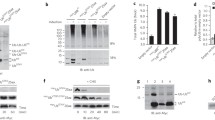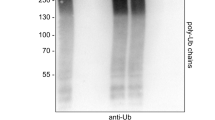Abstract
We have identified a novel ubiquitin conjugating enzyme gene, L-UBC, which maps to human Chromosome (Chr) 14q24.3. This is also the location of the major early onset familial Alzheimer's disease gene (FAD3). L-UBC encodes a protein that demonstrates homology to the yeast ubiquitin conjugating enzyme, UBC-4, and human UbcH5. Their functions are to ubiquitinate specific proteins targeted for degradation. The protein also exhibits very strong homology to a rabbit protein, E2-F1, which mediates p53 degradation driven by papilloma virus E6 protein in vitro. The accumulation of specific proteins that have undergone aberrant processing in neurofibrillary tangles and amyloid plaques is the classic pathological feature in brains of Alzheimer's disease patients. Abnormal ubiquitination has previously been suggested to play a role in the etiology of Alzheimer's disease. This gene therefore represents a plausible candidate gene for FAD3.
Similar content being viewed by others
References
Blumenfeld, N., Gonen, H., Mayer, A., Smith, C.E., Siegel, N.R., Schwartz, A.L., Ciechanover, A. (1994). Purification and characterisation of a novel species of ubiquitin-carrier protein E2 that is involved in degradation of non-“N-end rule” protein substrates. J. Biol. Chem. 269, 9574–9581.
Chau, V., Tobias, J.W., Bachmair, A., Marriot, D., Ecker, D.J., Gonda, D.K., Varshavsky, A. (1989). A multi-ubiquitin chain is confined to specific lysine in a targeted short-lived protein. Science 243, 1576–1583.
Chowdary, D.R., Dermody, J.J., Jha, K.K., Ozer, H.L. (1994). Accumulation of p53 in a mutant cell line defective in the ubiquitin pathway. Mol. Cell. Biol. 14, 1997–2003.
Ciechanover, A. (1994). The ubiquitin-proteasome proteolytic pathway. Cell 79, 13–21.
Ciechanover, A., Schwartz, A.L. (1994). The ubiquitin mediated proteolytic pathway: mechanisms of recognition of the proteolytic involvement in the degradation of native cellular proteins. FASEB J 8, 182–191.
Ciechanover, A., Shkedy, D., Oren, M., Bercovich, B. (1994). Degradation of the tumour suppressor protein p53 by the ubiquitin-mediated proteolytic system requires a novel species of ubiquitin-carrier protein. J. Biol. Chem. 269, 9582–9589.
Crane, D.I., Kalish, J.E., Gould, S.J. (1994) The Pichia pastaris PA54 gene encodes a ubiquitin-conjugating enzyme required for peroxisome assembly. J. Biol. Chem. 269, 21835–21844.
Deshaies, R.J., Chau, V., Kirschner, M. (1995). Ubiquination of the G1 cyclin Cln2p by a Cdc34p-dependent pathway. EMBO J. 14, 303–312.
Garruto, R.M., Brown, P. (1994). Tau protein, aluminium, and Alzheimer's disease. Lancet 343, 989.
Goate, A., Chartier-Harlin, M.C., Mullan, M., Brown, J., Crawford, F., Fidani, L., Giuffra, L., Haynes, A., Irving, N., James, L., Mant, R., Newton, P., Rooke, K., Roques, P., Talbot, C., Pericak-Vance, M., Roses, A., Williamson, R., Rosser, M., Owen, M., Hardy, J. (1991). Segregation of a mis-sense mutation in the amyloid precursor protein gene with familial Alzheimer's disease. Nature 349, 704–706.
Goedert, M., Spillantini, M.G., Cairns, N.J., Crowther, R.A. (1992). Tau proteins of Alzheimer paired helical filaments: abnormal phosphorylation of all six brain isoforms. Neuron 8, 159–168.
Goldberg, A.L., Rock, K.L. (1992) Proteolysis, proteosomes and antigen presentation. Nature 357, 375–379.
Haas, A.L., Rose, I.A. (1992) The mechanism of ubiquitin activating enzyme. J. Biol. Chem. 257, 10329–10337.
Haas, C., Koo, E., Mellon, A., Hung, A.Y., Selkoe, D. (1992). Targeting of cell surface β amyloid precursor protein to lysosomes: alternative processing into amyloid bearing fragments. Nature 357, 500–503.
Haas, C., Hung, A.Y., Selkoe, D.J., Teplow, D.B. (1994) Mutations associated with a locus for familial Alzheimer's disease result in alternative processing of amyloid β protein precursor. J. Biol. Chem. 269, 17741–17748.
Handley, P.M., Mueckler, M., Siegel, N.R., Ciechanover, A., Schwartz, A.L. (1991) Molecular cloning, sequence and tissue distribution of the human ubiquitin conjugating enzyme E1. Proc. Natl. Acad. Sci. USA 88, 258–262.
Hardy, J.A., Higgins, G.A. (1992). Alzheimer's disease: the amyloid cascade hypothesis. Science 256, 184–185.
Harrington, C.R., Wischik, C.M., McArthur, F.K., Taylor, G.A., Edwardson, J.A., Candy, J.M. (1994) Alzheimer's disease-like changes in tau protein processing: association with aluminium accumulation in brains of renal dialysis patients. Lancet 343, 993–997.
Hershko, A., Ciechanover, A. (1992) The ubiquitin system for protein degradation. Annu. Rev. Biochem. 61, 761–807.
Jalal, S.M., Law, M.E., Christensen, E.R., Spurbeck, J.L., Dewald, G.W. (1993) Method for sequential staining of GTL-banded metaphases with fluorescent-labelled chromosome specific paint probes. Am. J. Med. Genet. 46, 98–103.
Jentsch, S. (1992) The ubiquitin conjugation system. Annu. Rev. Genet. 26, 179–207.
Jentsch, S., Seufert, W., Sommer, T., Reins, H.J. (1990) Ubiquitin conjugating enzymes: novel regulators of eukaryotic cells. Trends Biochem. Sci. 15, 195–198.
Jentsch, S., Seufert, W., Hauser, H.P. (1991) Genetic analysis of the ubiquitin system. Biochim. Biophys. Acta 1098, 127–139.
Kaiser, P., Seufert, W., Hofferer, L., Kofler, B., Sachsenmaier, C., Herzog, H., Jentsch, S., Schweiger, M., Schneider, R. (1994) A human ubiquitin conjugating enzyme homologous to yeast UBC-8. J. Biol. Chem. 269, 8797–8802.
Kawashima, M.M., Hasegawa, M., Takio, K., Suzuki, M., Titani, K., Ihara, Y. (1993) Ubiquitin is conjugated with amino terminally processed tau in paired helical filaments. Neuron 10, 1151–1160.
Kay, G.F., Ashworth, A., Penny, G.D., Dunlop, M., Swift, S., Brockdorff, N., Rastan, S. (1991). A candidate spermatogenesis gene on the mouse Y chromosome is homologous to ubiquitin activating enzyme E1. Nature 354, 486–489.
Kok, K., Hofstra, R., Pilz, A., van den Berg, A., Terpstra, P., Buys, C.H.C.M., Carritt, B. (1993) A gene in the chromosomal region 3p21 with greatly reduced expression in lung cancer is similar to the gene for ubiquitin activating enzyme. Proc. Natl. Acad. Sci. USA 90, 6071–6075.
Koken, M.H.M., Smit, E.M.E., Jaspers-Dekker, I., Oostra, B.A., Hagemeijer, A., Bootsma, D., Hoeijmakers, J.H.J. (1992) Localisation of two human homologues HHR6A and HHR6B, of the yeast DNA repair gene RAD6 to chromosomes Xq24-q25 and 5q23-q31. Genomics 12, 447–453.
Koo, E.H., Squazzo, S.L. (1994) Evidence that production and release of amyloid β protein involves the endocytic pathway. J. Biol. Chem. 269, 17386–17389.
Kyte, J., Doolittle, R.F. (1982) A simple method for displaying the hydropathic character of a protein. J. Mol. Biol. 157, 105–132.
Landegent, J.E., Dewal, N.J.I., Dirk, R.W., Baas, F., Van der Ploeg, M. (1987). Use of whole cosmid cloned genomic sequences for chromosomal localisation by non-radioactive in situ hybridisation. Hum. Genet. 77, 336–370.
Lowe, J., Blanchard, A., Morrell, K., Lennox, G., Reynolds, L., Billet, M., Landon, M., Mayer, R.J. (1988) Ubiquitin is a common factor in intermediate filament inclusion bodies of diverse type in man, including those of Parkinson's disease, Pick's disease, and Alzheimer's disease, as well as Rosenthal fibres in cerebellar astrocytomas, cytoplasmic bodies in muscle and Mallory bodies in alcoholic liver disease. J. Pathol. 155, 9–15.
Mandelkow, E.M., Mandelkow, E. (1993) Tau as a marker for Alzheimer's disease, Trends Biochem. Sci. 18, 480–483.
McKhann, G., Drachman, D., Folsteine, M., Katzman, R., Price, D., Stadlan, E.M. (1984) Clinical diagnosis of Alzheimer's disease: Report of the NINCDS-ADRDA Workgroup under the auspices of the Department of Health and Human Services Task Force on Alzheimer's Disease. Neurology 34, 939–944.
Mori, H., Kond, J., Ihara, Y. (1987). Ubiquitin is a component of paired helical filaments in Alzheimer's disease. Science 235, 1641–1644.
Mullan, M., Houlden, H., Windenlspecht M., Fidani, L., Lombardi, C., Diaz, P., Rosser, M., Crook, R., Hardy, J., Duff, K., Crawford, F. (1992). A locus for familial early onset Alzheimer's disease on the long arm of chromosome 14, proximal to the α-1-antichimotrypsin gene. Nature Genet. 2, 340–342.
Muralidhar, M.G., Thomas, J.B. (1993) The drosophila bendless gene encodes a neural protein related to the ubiquitin-conjugating enzymes. Neuron, 11, 253–266.
Palombella, V.J., Rando, O.J., Goldberg, A.L., Maniatis, T. (1994). The ubiquitin-proteasome pathway is required for processing the NF-κB1 precursor protein and the activation of NF-κB. Cell, 773–785.
Paolini, R., Kinet, J.-P., (1993) Cell surface control of the multiubiquination and deubiquination of high-affinity immunoglobulin E receptors. EMBO J. 12, 779–786.
Papa, F.R., Hochstrasser, M. (1993) The yeast DOA-4 gene encodes deubiquitinating enzyme related to a product of the human tre-2 oncogene. Nature 366, 313–319.
Perry, G.P., Friedman, R., Shaw, G., Chau, V. (1987). Ubiquitin is detected in neurofibrillary tangles and senile plaque neurites of Alzheimer's disease brains. Proc. Natl. Acad. Sci. USA 84, 3033–3036.
Plon, S.E., Leppig, K.A., Do, H.N., Groudine, M. (1993). Cloning of the human homologue of the CDC34 cell cycle gene by complementation in yeast. Proc. Natl. Acad. Sci. USA 90, 10484–10488.
Reiss, Y., Heller, H., Hershko, A. (1989) Binding sites of ubiquitin protein ligase. J. Biol. Chem. 264, 10378–10383.
Robinson, P.A., Marley, J.J., High, A.S., Hume, W.J. (1994). Differential expression of protease inhibitor genes between normal human oral tissue and odontogenic keratocysts. Arch. Oral. Biol. 39, 251–259.
Rolfe, M., Beer-Romero, P., Glass, S., Eckstein, J., Berdo, I., Theodoras, A., Pagano, M., Draetta, G. (1995). Reconstitution of p53-ubiquinylation reactions from purified components: the role of human ubiquitin-conjugating enzyme UBC4 and E6-associated protein (E6AP). Proc. Natl. Acad. Sci. USA 92, 3264–3268.
Sambrook, J., Fritsch, E.F., Maniatis, T. (1989) Molecular Cloning: A Laboratory Manual, 2nd ed. (Cold Spring Harbor, N.Y.: Cold Spring Harbor Laboratory Press).
Scheffner, M., Huibregtse, J.M., Howley, P.M. (1994) Identification of a human ubiquitin-conjugating enzyme that mediates the E6-AP-dependent ubiquitination of p53. Proc. Natl. Acad. Sci. USA 91, 8797–8801.
Schellenberg, G.D., Bird, T.D., Wijsman, E.M., Orr, H.T., Anderson, L., Nemens, E., White, J.A., Bonneycastle, L., Weber, J.L., Alonso, M.E., Potter, H., Heston, L.L., Martin, G.M. (1992) Genetic linkage evidence for a familial Alzheimer's disease locus on chromosome 14. Science 258, 668–671.
Seufert, W., Jentsch, S. (1990) Ubiquitin conjugating enzymes UBC-4 and UBC-5 mediate selective degradation of short-lived and abnormal proteins. EMBO J. 9, 543–550.
Seufert, W., Futcher, B., Jentsch, S. (1995) Role of ubiquitin conjugating enzyme in degradation of S- and M-phase cyclins. Nature 373, 78–81.
St George-Hyslop, P., Haines, J., Rogaev, E., Mortilla, M., Vaula, G., Periak-Vance, M., Foncin, J.F., Montesi, M., Bruni, A., Sorbi, S., Rainero, I., Pinessi, L., Pollen, D., Polinsky, R., Nee, L., Kennedy, J., Macciardi, F., Rogaeva, E., Liang, Y., Alexandrova, N., Lukiw, W., Schlumpf, K., Tanzi, R., Tsuda, T., Farrer, L., Cantu, J.M., Duara, R., Amaducci, L., Bergamini, L., Gusella, J., Roses, A., Mclachlan, D. (1992). Genetic evidence for a novel familial Alzheimer's disease locus on chromosome 14. Nature Genet. 2, 330–334.
Treier, M., Seufert, W., Jentsch, S. (1992). Drosophila UbcD1 encodes a highly conserved ubiquitin-conjugating enzyme involved in selective protein degradation. EMBO J. 11, 367–372.
Van Broeckhoven, C., Backhovens, H., Cruts, M., De Winter, G., Bruyland, M., Cras, P., Martin, J.J. (1992) Mapping of a gene predisposing to early onset Alzheimer's disease to chromosome 14q24.3. Nature Genet. 2, 335–339.
Zhen, M., Heinlein, R., Jones, D., Jentsch, S., Candido, E.P.M. (1993) The ubc-2 gene of Caenorhabditis elegans encodes a ubiquitin-conjugating enzyme involved in selective protein degradation. Mol. Cell. Biol. 13, 1371–1377.
Author information
Authors and Affiliations
Rights and permissions
About this article
Cite this article
Robinson, P.A., Leek, J.P., Thompson, J. et al. A human ubiquitin conjugating enzyme, L-UBC, maps in the Alzheimer's disease locus on Chromosome 14q24.3. Mammalian Genome 6, 725–731 (1995). https://doi.org/10.1007/BF00354295
Received:
Accepted:
Issue Date:
DOI: https://doi.org/10.1007/BF00354295




